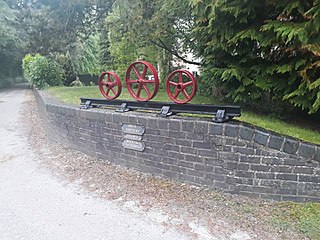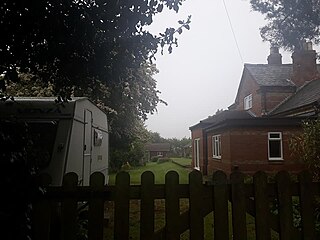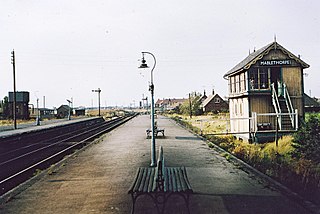
The Great Northern Railway (GNR) was a British railway company incorporated in 1846 with the object of building a line from London to York. It quickly saw that seizing control of territory was key to development, and it acquired, or took leases of, many local railways, whether actually built or not. In so doing, it overextended itself financially.

Bardney is a village and civil parish in the West Lindsey district of Lincolnshire, England. The population of the civil parish was 1,643 at the 2001 census increasing to 1,848 at the 2011 census. The village sits on the east bank of the River Witham and 9 miles (14 km) east of the city and county town of Lincoln.

Withcall is a small farming village and civil parish in the East Lindsey district of Lincolnshire, England. It lies within the Lincolnshire Wolds, and 4 miles (6.4 km) south-west from Louth.
The Lancashire, Derbyshire and East Coast Railway (LD&ECR) was built to connect coalfields in Derbyshire and Nottinghamshire with Warrington and a new port on the Lincolnshire coast. It was a huge undertaking, and the company was unable to raise the money to build its line. With the financial help of the Great Eastern Railway it managed to open between Chesterfield and Lincoln with a branch towards Sheffield from 1896. Despite efforts to promote tourist travel, the passenger business was never buoyant, but collieries were connected to the line, at first and in succeeding years. The Great Eastern Railway, and other main line companies, transported coal to the southern counties, and the company's engines took coal to Immingham in great quantities. The company had a fleet of tank engines.
Kingthorpe railway station was a railway station that served the village of Kingthorpe, Lincolnshire, England between 1874 and 1956, on the Louth to Bardney line.

Wragby railway station was a railway station that served the town of Wragby, Lincolnshire, England between 1874 and 1960, on the Louth to Bardney line.

East Barkwith railway station was a railway station that served the village of East Barkwith, Lincolnshire, England between 1874 and 1958, on the Louth to Bardney line.

South Willingham and Hainton railway station was a railway station that served the village of South Willingham, Lincolnshire, England between 1874 and 1958, on the Louth to Bardney line.

Donington railway station was a station in the village of Donington on Bain, Lincolnshire, England.

Withcall railway station was a station in Withcall, Lincolnshire, England.

Hallington railway station was a station in Hallington, Lincolnshire.
The Ambergate, Nottingham and Boston and Eastern Junction Railway was a British railway company, which hoped to connect Lancashire with the port of Boston, in Lincolnshire. It was authorised in 1846 but was unable to raise much money. It opened a standard gauge line from a junction near Nottingham to Grantham in 1853. At Nottingham it was to rely on the Midland Railway, but that company was hostile and obstructive.

The East Lincolnshire Railway was a main line railway linking the towns of Boston, Louth and Grimsby in Lincolnshire, England. It opened in 1848. The ELR Company had leased the line to the Great Northern Railway, and it was the latter which constructed the line and operated it, as its East Lincolnshire Line.
The Kirkstead and Little Steeping Railway, locally known as the New Line, was a railway line in England built to shorten the route between Lincoln and Firsby in Lincolnshire, England.

The Lincolnshire loop line was a 58-mile (93 km) double-track railway built by the Great Northern Railway, that linked Peterborough to Lincoln via Spalding and Boston.
The Horncastle and Kirkstead Junction Railway was a seven mile long single track branch railway line in Lincolnshire, England, that ran from Horncastle to Woodhall Junction on the Great Northern Railway (GNR) line between Boston and Lincoln. There was one intermediate station, Woodhall Spa.

South Willingham is a village and civil parish in the East Lindsey district of Lincolnshire, England, and partly within the Lincolnshire Wolds Area of Outstanding Natural Beauty,. It is situated 1 mile (2 km) south of the A157 Lincoln to Louth road, 15 miles (24 km) west of Lincoln, where the central Lincolnshire Vale and the Lincolnshire Wolds meet. Its population was 160 at the 2011 census, down from a maximum of 341 in 1851.

The Mablethorpe Loop railway was formed in Lincolnshire, England, by two independent railway companies, which built branches from the East Lincolnshire Line.
The Grantham and Lincoln railway line was a line in Lincolnshire, built by the Great Northern Railway to shorten the distance between the town of Grantham and city of Lincoln. It had already formed a network in Lincolnshire, but the route from London and points south and west of Grantham was very indirect.
The Lincolnshire lines of the Great Northern Railway are the railways, past and present, in the English county built or operated by the Great Northern Railway.
















